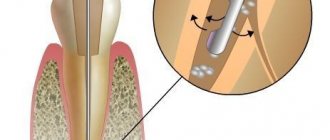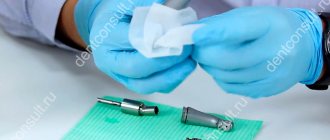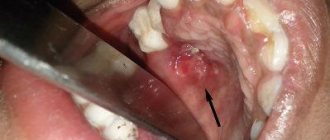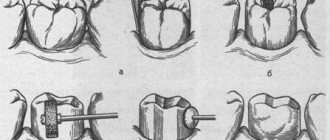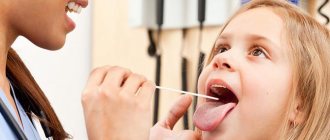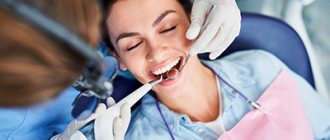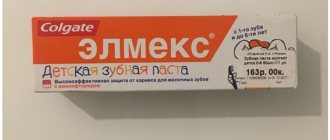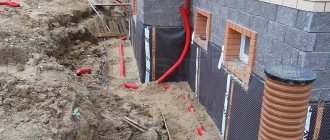Knowledge of the sanitary and hygienic standards required for the organization of a dental office is the basis for the rational organization of the work of a dentist. The current unfavorable epidemiological situation determines the need for an in-depth study of the issues of disinfection and sterilization of medical instruments.
Asepsis —
a method of preventing the penetration of microbes into a wound or body during diagnostic and therapeutic procedures. It is achieved by: sterilization
linen, dressings, suture material, instruments, preparation of the hands of medical personnel, surgical field.
Antiseptics are a set of measures to limit and destroy infection that has entered a wound.
Types of antiseptics: physical, mechanical, chemical, biological.
Physical antiseptics consists of creating conditions unfavorable for the life of microbes (drying, heat and light procedures).
Mechanical antiseptics consists of treating infected tissues in order to remove pathogenic microorganisms and their metabolic products. In dentistry, mechanical antiseptics include: preparation of carious cavities, mechanical treatment of root canals.
Chemical antiseptics is the use of various chemicals with bactericidal or bacteriostatic effects.
Biological antiseptics are aimed at increasing the body's defenses, as well as creating conditions unfavorable for the development of microorganisms in the wound. The following types of sterilization are used in dentistry: boiling, steam under pressure, dry heat and cold.
Boiling is used to sterilize all-metal instruments. To reduce scale formation, use distilled water with the addition of sodium bicarbonate (baking soda) to obtain a 1 - 2% solution.
Steam under pressure sterilizes dressings, underwear, gloves, cotton balls, turundas, as well as metal instruments in steam or electric autoclaves. Usually, the material is packaged in boxes or bags before sterilization.
Disinfection of dental instruments
Disinfection of dental instruments is carried out by immersing them in a disinfectant solution. For products and their parts that are not in direct contact with the patient’s oral mucosa (tips, light guides of photopolymerizers), the method of wiping twice with an interval of 15 minutes can be used.
Wash water is disinfected by boiling for 30 minutes or covered with dry bleach at the rate of 200 grams per 1 liter, mixed and kept for 60 minutes.
After use, single-use plastic products are immersed in a specially marked container with a 5% solution of chloramine or a 1.5% solution of neutral calcium hypochlorite.
The tips, after each patient’s use, are removed and the outer surfaces and the boron channel are thoroughly wiped with a sterile swab twice, after 15 minutes, followed by an exposure of 45 minutes, with a swab moistened with a 3% chloramine solution or 70° alcohol.
The working surface of tables for sterile instruments and the wall along their length are wiped with a special rag moistened with a 1% chloramine solution.
After each patient, the dentist’s table is disinfected with a napkin soaked in a 1% solution of chloramine or 3% hydrogen peroxide or disinfectant wipes “Hexidis Plus”, “Diaseptic-30C”, “Avansept” and others.
Dentists should work in rubber (latex) gloves, which, after seeing a patient (without contamination with blood), are washed under running water with soap twice, followed by treating them with 70° alcohol for 2 minutes before seeing the next patient. If gloves are contaminated with blood, disinfection is carried out using 6% hydrogen peroxide or 3% chloramine for 60 minutes in a marked container. To work with another patient, take a new pair of gloves.
Medical Internet conferences
Substances for treating root canals must meet certain requirements: 1. Be bactericidal for microorganisms located in the root canals; 2.Have a quick effect and penetrate deeply into the dentinal tubules; 3.Do not lose its effectiveness in the presence of organic substances; 4.Do not have a smell or specific taste; 5.Be chemically resistant and remain active during long-term storage; 6.Be harmless to periapical tissues and promote their regeneration; 7.Do not have a sensitizing effect and do not cause the emergence of resistant forms of microorganisms. Basic provisions justifying the need for disinfection of root canals: 1. Complex anatomy of root canals, which provides a favorable environment for the growth, reproduction and interaction of microorganisms; 2. In teeth with necrotic pulp and inflammation of the root apex, gram-negative anaerobes predominate; 3. Microorganisms are present in all areas of the root canal, including lateral canals, anastomoses and dentinal tubules at a depth of up to 300 µm; 4. Microorganisms receive nutrition from living or necrotic pulp, salivary proteins and periodontal tissue fluid, and from other bacteria; 5. The waste products of microorganisms negatively affect pulp tissue and are toxic to periodontal tissue. Classification of antiseptics for root canal treatment: 1. Halides 2. Oxidizing agents 3. Nitrofuran preparations 4. Quaternary ammonium compounds 5. Urea or urea 6. Proteolytic enzymes 7. Complexones (chelates). Halides include two types of drugs - chlorine-containing and iodine-containing. Chlorine-containing preparations are presented: 0.05-0.06% chlorhexidine solution, 2-4% chloramine B solution, 1-5% sodium hypochlorite solution, 2% aqueous solution of chloramine T. The mechanism of action of these drugs is based on the release of chlorine gas, which penetrates into the dentinal tubules, disinfecting their contents and destroying organic residues. The most common drug in this group is sodium hypochlorite . The drug was first proposed by G. Deyikn as a wound disinfectant during the First World War, and only a few years later this antiseptic began to be used for root canal irrigation. It has a number of properties that have made it so popular in endodontics: the unique ability to dissolve the organic contents of root canals: necrotic tissue, decay products, scraps of extirpated pulp; pH values range from 11 to 12; pronounced antimicrobial effectiveness, bactericidal effect, consisting in the oxidation and hydrolysis of proteins in microbial cells; is a good lubricant; chemically resistant; has whitening properties; economically beneficial. Sodium hypochlorite, when interacting with tissue proteins, quickly disintegrates, releasing atomic chlorine, which combines with amino groups to form a substance called chloramine and, as a result of the resulting reactions, peptide bonds are broken, proteins dissolve, and do not coagulate, as with the action of other disinfectants. As a result, chloramine disinfects the root canal, which has already been cleared of organic matter, and also dissolves the contents of the lateral tubules or apical delta, which cannot be processed instrumentally. The negative properties of sodium hypochlorite, as well as various other chlorine-containing compounds, are the following: decreased activity in the presence of organic substances, which makes it necessary to re-rinse the root canals; have an irritating effect on periodontal tissue; have a specific, unpleasant odor. It is presented on the market in the form of preparations: Edetal gel (5 ml Omega-Dent, Russia), Parkan (250 ml, Septodont, France), Belodez (30 ml, 100 ml Vladmiva, Russia). Iodine-containing include : 1% aqueous solution of iodinol containing iodine, potassium iodide, polyvinyl alcohol, distilled water. The drug has bactericidal and fungicidal properties due to the action of molecular iodine, it also accelerates regeneration and phagocytosis, has a prolonged effect and is also an indicator of the cleanliness of the root canal (the drug has a blue tint, but upon contact with necrotic tissues, discoloration occurs). A well-known representative of the group of oxidizing agents is hydrogen peroxide, used in the form of a 3% solution. Hydrogen peroxide has a bactericidal effect due to the release of molecular oxygen upon contact with organic tissues, especially against gram-negative microflora. The advantage of this substance is also its hemostatic properties. The disadvantage of a 3% hydrogen peroxide solution is the lack of ability to dissolve necrotic tissue and organic residues, therefore it is recommended to alternately use solutions of hydrogen peroxide and sodium hypochlorite; the interaction reaction between these substances leads to the release of free chlorine and oxygen, which enhances the cleansing and bactericidal properties of these substances. Quaternary ammonium compounds. Includes 1% decamin solution , 15% decamintoxin, biosept. These drugs have bactericidal, bacteriostatic and fungicidal effects, are active in the presence of organic substances, have an anesthetic effect and enhance the effect of other antiseptics. In endodontic practice, drugs based on urea (carbamide) , for example the drug Cly-oxide , the drug is a 10% solution of urea peroxide in glycerin. In addition to the lack of toxicity, the drugs have an antiseptic effect, lyse necrotic tissue, and also potentiate the effect of antibiotics. Drugs of the nitrofuran series include 0.5% solution of furatsilin , 0.1-0.15% solution of furadonin, furagin, furazolidone. The positive properties of these substances include their bactericidal effect on gram-positive and gram-negative microflora, as well as on fungi, stimulate phagocytosis and have an anti-exudative effect. A group of proteolytic enzymes. This group includes preparations of trypsin and chemotrypsin , which are prepared immediately before use - ex temporae, by diluting the crystals in a 0.9% isotonic solution of sodium chloride or 0.5% novocaine solution. This group also includes immobilized enzymes - stomatozyme, immozymase, produced in the form of a gel, ready for use. Proteolytic enzymes are capable of lysing necrotic tissue, have an anti-inflammatory and anti-exudative effect, have an anticoagulant effect, and also deprive microorganisms of a nutrient medium due to which they exhibit an indirect bacteriostatic effect. But despite a number of positive properties, these root canal treatment products often lead to the development of allergic reactions and are also quickly inactivated.
Comparative table of the main properties of representatives of the main groups of antiseptics for root canal treatment:
| Antiseptics | Bactericidal | Toxicity | Having an unpleasant odor or taste | Action in the presence of org. substances | Efficiency |
| Sodium hypochlorite | +++ | +++ | +++ | +++ | +++ |
| Hydrogen peroxide | +++ | ++ | — | — | ++ |
| Chlorhexidine | +++ | — | — | +++ | ++ |
| Urea | +++ | — | + | +++ | ++ |
Unfortunately, today antiseptic solutions of the nitrofuran series have lost their importance in endodontic practice, as some strains of microorganisms have developed resistance to nitrofurans, which has led to a sharp drop in the effectiveness of these drugs. It should be said that an analysis of medical records of dental patients allows us to draw conclusions that the use of sodium hypochlorite in endodontics gives better results than other disinfectants, which is due to the distinctive abilities of its antimicrobial action. It is important to remember that when working with this substance, it is necessary to strictly observe all safety measures: rubber dam, saliva ejector, vacuum cleaner, in order to avoid contact of the antiseptic with the oral mucosa. Complications associated with the use of the drug occur, first of all, due to the release of the drug beyond the top of the canal, which leads to the development of swelling, bleeding, pain, and in some cases, the development of parasthesia and secondary infection is possible.
Based on the material presented, we can conclude that in modern endodontics there is no universal remedy that fully meets all the requirements and is capable of destroying all the diverse microflora found in infected dental tissues; but we can definitely say that medical treatment of root canals using antiseptics is an important stage of endodontic treatment and allows you to avoid possible dangerous complications not only on the tissue of the maxillofacial area, but also on the entire body as a whole.
Methods for disinfecting dental instruments
| Disinfection method | Disinfectant agent | Solution concentration % | Disinfection time (min) | Application |
| Physical - boiling. | A) Distilled water. B) Distilled water with sodium carbonate. | 2,0 | 30 15 | Recommended for glass products, metal, heat-resistant polymers. |
| Chemical. | A) Chloramine. | 3,0 | 60 | Products made of glass, corrosion-resistant metal, polymer materials. |
| B) Hydrogen peroxide. | 6,0 | 60 | Products made of glass, corrosion-resistant metal. | |
| B) Neutral calcium hypochlorite | 4,5 | 60 | Products made of glass, polymer materials. | |
| D) Glutaraldehyde. | 2,5 | 60 | Products made of glass, corrosion-resistant metal | |
| D) Formalin. | 4,0 | 60 | Products made of glass, polymer materials. | |
| E) Neutral anolyte. | 0,05 | 180 | Rubber products. | |
| Neutral anolyte. | 0,05 | 60 | Products made of plastic. | |
| Neutral anolyte. | 0,05 | 30 | Glass products. |
Pre-sterilization treatment
Pre-sterilization treatment involves removing protein, fatty contaminants and residues of medications and materials from the surface of products. Pre-sterilization cleaning is carried out manually or mechanically.
The manual cleaning method includes a number of successive steps: removing residual disinfectants (products are thoroughly washed with running water); soak for 15 minutes in a cleaning solution (preheated) provided that the instruments are completely immersed. The heating temperature when using “Biolot” is 40-45°C, when using hydrogen peroxide with CMC “Lotos”, “Progress” and analogues - 50-55°C. A water thermometer is used to determine the temperature. Cleaning each instrument in a cleaning solution using a brush or a cotton-gauze swab - 30 seconds, while the temperature of the solution is not maintained during the washing process. Rinsing with running water when using Biolot detergent - 3 - 4 minutes, Progress, Marichka, sodium bicarbonate - 5 minutes, the rest CMC - 10 minutes. Rinse with distilled water - 30 seconds for each instrument. Drying with hot air until moisture completely disappears in a drying cabinet at 85°C
The following samples are used to control pre-sterilization treatment.
Azopyram test . To prepare 1 liter of azopyram solution, take 100 grams of azopyram and 1.0 - 1.5 grams of analine hydrochloride. The substances are mixed and filled with 95% alcohol to a volume of 1 liter.
Before checking the quality of cleaning of products, prepare a working solution by mixing equal volumes of the original solution and 3% hydrogen peroxide. The resulting solution
Apply to cotton wool and wipe the instrument. In the presence of traces of blood, no later than 1 minute after contact of the reagent with the contaminated instrument, a violet color will appear, turning into pink-lilac.
Amidopyrine test.
Mix equal amounts of a 5% alcohol solution of amidopyrine, 30% acetic acid and a 3% solution of hydrogen peroxide (2-3 ml each). When conducting tests, apply 2-3 drops of the reagent to the controlled instrument. When contaminated with blood, a blue-green color appears.
Phenolphthalein test. Prepare a 1% alcohol solution of phenolphthalein. Apply 1 - 2 drops of the reagent to the washed item. If there is residual detergent, a pink color will appear.
Asepsis
U
Rice.
2.3. The position of the doctor when working with the patient (a) and in accordance with the clock dial (8-12) (b).
Rice. 2.4.
Incorrect position of the doctor near the patient's chair when working sitting (a) and standing (b).
20
Rice.
2.5. Safety glasses, mask and gloves.
work allows you to increase labor productivity, prevent the occurrence of occupational diseases and promote professional longevity.
2.4. Asepsis and antisepsis in dentistry
Asepsis
-
a system of preventive measures aimed the wound, organs and tissues of the patient during any medical procedures
Asepsis includes sterilization of instruments, devices, etc., special treatment of the surgeon’s hands, adherence to special techniques during medical procedures, and implementation of special hygienic and organizational measures.
There are 5 methods of infection of a wound surface: air, droplet, contact, implantation, mixed.
Antiseptics is a system of measures aimed at reducing
The concept of “antiseptics” was first introduced by the English military surgeon Rpp§1 in 1750. The modern history of antiseptics is associated with the names of the Viennese obstetrician J. Simmel-Weiss and the English surgeon J. Lister. It is known that methods of combating infection, suppuration of wounds and the putrefactive process in them existed before the introduction of this concept.
Antiseptic methods:
- mechanical (removal of microorganisms by excision of infected wound edges; washing);
- physical (drying wounds with hygroscopic dressings, applying bandages with a hypertonic solution, draining cavities, aspiration of wound contents, irradiation with ultraviolet light);
- biological (use of antibiotics, bacteriophages, vaccines and serums).
An important element of asepsis is sterilization. Sterilization is a combination of physical and chemical methods
21
complete liberation of environmental objects (instruments, dressings, etc.) from microorganisms and their spores. All products that come into contact with the wound surface, blood, injectable drugs, etc. are subject to sterilization.
There are types of sterilization using physical and chemical factors. Physical factors - high temperatures (boiling, dry heat sterilization, autoclaving - the action of steam under pressure), ultrasonic, ultraviolet radiation (Fig. 2.6; 2.7), chemical factors - the use of chemicals (formalin, 1-3 chloramine solution, 6% hydrogen peroxide solution, triple solution, 70% alcohol, etc.). This type of sterilization is called “cold sterilization.”
The sterilization process includes several stages.
1.
Disinfection.
Disinfection is a set of measures for the complete or partial destruction of microorganisms from environmental objects (instruments, dressings, etc.), the wound surface or surgical field, the hands of a doctor and medical personnel.
Disinfection of instruments, glasses, glass plates, etc. is carried out by soaking in solutions of potent antiseptics.
Before disposal, used dressings, gloves, etc. are disinfected in a 5% alaminol solution for 60 minutes; if there is blood on them, an 8% alaminol solution is used. To disinfect the skin of the surgical field, use 70% alcohol, 2% iodine solution, etc., with which it is subsequently treated.
Hand treatment by a dentist is important. There are several methods for treating a doctor’s hands before performing surgical procedures, using various antiseptic drugs (iodine, chlorhexidine, “Lysanine”). After surgical disinfection of hands (washing followed by treatment with a 0.5% alcohol solution of chlorhexidine, etc. for 2-3 minutes), in order to perform the operation aseptically, it is necessary to use sterile rubber gloves.
2.
Pre-sterilization cleaning.
This cleaning is usually done manually at room temperature (after disinfection). Medical instruments are first washed in running water for 2-3 minutes, and then soaked in distilled water for 10-15 minutes. Detachable products are immersed in the solution in disassembled form. If there are locking parts, the instruments are soaked open. For additional pre-sterilization cleaning of small instruments from mechanical contaminants, you can use a special ultrasonic device (“Serga”, etc.). After soaking, an azopyram test is performed to identify
22
Rice. 2.6.
Dry heat sterilizer.
Rice. 2.7. Autoclave.
23
Rice. 2.8.
Device "Az81811pa" for pre-sterilization treatment of dental handpieces.
"hidden" blood. The sample is regarded as positive if, 1 minute after contact of the reagent with the contaminated area, a violet color appears, quickly turning into pink-lilac
or brownish. After pre-sterilization cleaning, the instruments are thoroughly dried.
Dental handpieces require special care due to the complexity of the device. Disinfection, pre-sterilization cleaning and lubrication of tips can be done in the “A8§1§1sha” device: the disinfectant solution and lubricating oil are supplied under pressure into the tip fixed in the device (Fig. 2.8).
In modern dental practice, the Terminator device is used, which allows disinfection and cleaning of the tip in 3 seconds.
- Placing instruments in the sterilizer.
When sterilizing in a dry-heat oven, dental instruments are placed in trays using the “well” method. When autoclaving a dressing, it is first placed in special containers.
- Actually sterilization.
Such sterilization is carried out in a dry-heat oven, an autoclave, sterilizers for boiling instruments, and a glassperlene sterilizer (Fig. 2.9). The latter is used for sterilization of small dental instruments (burs, endodontic instruments, etc.). During chemical sterilization, instruments (mirrors, etc.) are immersed in special containers with solutions of strong antiseptics.
In modern conditions, dry-heat ovens are more often used to sterilize instruments, while a certain regime is observed: temperature 180 ° C, time 60 minutes. Sterility is controlled by a special indicator tape placed at 5 points in the dry-heat oven. Dental handpieces are sterilized in special autoclaves.
Rice. 2.9.
Glass perlen sterilizer.
Storage of sterile
instruments and material.
I
Instruments are stored on a sterile table under a sterile sheet. If you need to get tools, the sheet is lifted with special holders (forceps). To store sterile instruments, you can use a special ultraviolet shelf (Fig. 2.10).
Devices are also used for laminating instruments after sterilization into special bags.
Sterile dressings are stored in metal containers with the date of sterilization indicated on the attached label.
'••• (4^ ^. .„,. ^ _ «^ . „„^ ) ^ ._.,„,„ „^ „and ,
Disinfection of casts and models is important for preventing infection of medical personnel and patients. Casts, which can be a depot for pathogenic microflora, should be washed with running water, then treated with a 2% glutaraldehyde solution or other antiseptic agents. Currently, there is a special Higojet device for disinfecting impressions. To disinfect hands, instruments, handpieces, prostheses, etc., the universal device “Nebucid” is used. |
Rice. 2.10.
Ultraviolet shelf for storing sterile instruments.
24
25
Particular attention is paid to the prevention of hepatitis and HIV infection. When performing dental interventions, especially manipulations with cutting and piercing instruments (needles, scalpels, burs, separation discs for preparing teeth, etc.), special precautions must be taken. Health care workers should treat blood, saliva, and other body fluids as potentially infectious materials. Before work, you must wear safety glasses or plastic shields, a protective face mask, and disposable gloves. After examining a patient or after each procedure, when working with infected material, you must wash your hands thoroughly.
If there is a risk of contracting HIV infection, medical personnel must carry out all manipulations with double gloves. Gloves are not reused. During work, gloves are treated with 70% alcohol or other antiseptic agents.
If gloves are punctured and the skin is damaged, it is necessary to treat the gloves with disinfectant solutions, then remove them, squeeze out the blood from the wound, wash your hands under running water and soap, treat the skin of your hands with 70% alcohol and lubricate the wound with 5% tincture of iodine. Hands contaminated with blood are immediately treated for 30 seconds with a swab moistened with a skin antiseptic (70% alcohol, 3% chloramine solution, actiniderm, actinisept, chlorhexidine). After this, hands are washed twice with warm running water and soap, and wiped dry with an individual towel.
If blood or other biological fluids come into contact with the mucous membrane of the eyes, it is necessary to rinse the eyes with water or a 1% solution of boric acid. If blood gets on the nasal mucosa, a 1% solution of protargol should be dripped into the nose. If blood or other biological fluids come into contact with the oral mucosa, rinse your mouth with 70% alcohol, or 0.005% potassium permanganate solution, or 1% boric acid solution. In case of violation of the integrity of the skin (wounds, scratches, weeping dermatitis), the medical worker is suspended from work.
The risk of spreading infection is significantly reduced if the patient rinses the mouth before treatment. Thus, rinsing with water only reduces the number of microorganisms in aerosols by 75%, and the use of special mouth rinses by 98%.
A medical worker who is injured while providing dental care to an HIV-infected patient is monitored for 12 months with research
26
blood tests after 3, 6 and 12 months at the AIDS center. Immediately after injury, it is necessary to prevent HIV infection with the help of special antiretroviral drugs.
For sanitary and hygienic treatment of the dental office, in addition to daily cleaning of the room, during therapeutic or orthopedic appointments, general cleaning is required once a month using disinfectants: 1% chloramine solution or 0.05% septodora solution. In the surgical room, general cleaning should be carried out more often - once a week.
Sterilization
Sterilization is aimed at destroying all forms of microorganisms, including spore forms. Prevents the spread of a number of infectious diseases whose pathogens are transmitted through blood and biological fluids (viral hepatitis, HIV infection). Dental kits in trays, mixing glasses, mirrors, burs and other instruments are subject to sterilization. The following sterilization methods exist: steam, air, chemical, gas.
The steam sterilization method is used for products made of textile materials (underwear, dressings), rubber (gloves, tubes, catheters, bougies). Autoclaving is carried out at a pressure of 2 atmospheres (+/- 0.2) for 20 minutes at a temperature of 132°C for glass products, resistant metals, textile materials, silicone rubber. At a pressure of 1.1 atmospheres - 45 minutes, at a temperature of 120°C, products made of rubber, latex, and certain polymer materials are sterilized.
The air method of sterilization in dry-heat ovens is recommended for glass and metal products. Sterilization mode 180°C - 60 minutes. Each cycle of operation of the sterilizer is recorded in the sterilization log, where the name and
quantity of all products, parameters and results of sterilization control.
Sterilization methods
| Sterilization methods | Means and conditions | Tools |
| 1. Dry heat method. | Dry oven -180 degrees 60 minutes. | Small dental instruments, trays with a set of dental instruments. |
| 2. Cold (chemical) sterilization. | Before sterilization, instruments are treated with a mixture of 0.5% hydrogen peroxide solution and Lotus detergent. The instruments are placed in a tray with an antiseptic solution for 40-45 minutes. 6% hydrogen peroxide 6% hydrogen peroxide 1% dezoxon-1 solution 2.5% glutaraldehyde solution 8% lysoformin-3000 solution | Dental mirrors, sharp cutting objects, plastic spatula. at 18-20°C - 6 hours at 50°C - 3 hours at 18°C - 45 min at 20°C - 6 hours at 50°C - 1 hour. |
| 3.Boiling method in normal or alkaline water. | 30-40 minutes. Sodium bicarbonate (baking soda) 10-20 g per liter of water is added to the water (to prevent oxidation). | Syringe, needles, burs, instruments for filling teeth. |
| 4. Boiling in Vaseline oil followed by centrifugation. | Method for performing surgical operations. | Dental handpieces. |
| 5. Disinfection (instruction of the USSR Ministry of Health dated March 1, 1977). | Wipe twice with a sterile cotton-gauze swab with a solution of chloramine, 3% formaldehyde solution (optional with an interval between wipes of 10-15 minutes). | Dental handpieces. |
| 6. Boiling brushes. | Place in a disinfectant solution for 2 - 3 hours, then boil for 40 minutes. | Brushes for washing hands. |
antiseptics in dentistry
| Definition Antiseptics and disinfectants refer to antimicrobial agents that lack selectivity of antimicrobial action (they are active against most microorganisms, protozoa and fungi and do not cause the development of resistance). Antiseptics are used to destroy pathogens located on the surface of human tissue. They are applied to the skin and mucous membranes (including the gastrointestinal tract and urinary tract); in dentistry they are used to treat pathological periodontal pockets with periodontal disease, root canals and tooth cavities. The mechanism of action of most antiseptics is associated with their ability to denature proteins (structural and enzymatic) and thus have a bactericidal effect. Due to the lack of selectivity, antiseptics are organotropic in relation to the macroorganism). Classification and main representatives Antiseptics and disinfectants are classified according to their chemical structure: I. Halogen-containing compounds (derivatives of chlorine, iodine, etc.). Antiseptics of this group have a pronounced bactericidal, sporicidal, fungicidal and deodorizing effect. The most active drugs are those containing elemental halogens or releasing them (bleach solution, chloramine B, alcoholic iodine solution, Lugol's solution, iodinol, iodocam, iodoform, pantocid). II. Oxidizing agents (potassium permanganate, hydrogen peroxide solution, hydroperite). The principle of action of drugs in this group is the release of oxygen and oxidation of organic components of the protoplasm of microorganisms. They have a deodorizing effect. A solution of hydrogen peroxide helps to mechanically cleanse the wound and stop bleeding. III. Antiseptics of the phenol group (pure phenol, resorcinol, tricresol, ferozol, resorcinol, benzonaphthol, vagotil). Phenol has bactericidal, sporicidal and fungicidal effects. Irritates tissue, is easily absorbed from the site of application, toxic. It is used as an antiseptic in dentistry during root canal treatment and necrotization of the dental pulp. Vagotil has a local bactericidal and trichomonacid effect. Resorcinol is inferior to phenol as an antiseptic. In small concentrations it has a keratoplastic effect, and in large concentrations it has a keratolytic and cauterizing effect. The phenol group also includes eugenol (allylguaiacol), which is the main component of clove oil and has a disinfectant and local anesthetic effect. IV. Aliphatic antiseptics from the group of alcohols and aldehydes (formaldehyde solution, hexamethylenetetramine (methenamine), ethyl alcohol, beta-1-lysoform, cyminal). Formaldehyde preparations have antimicrobial, sporicidal, deodorizing, dehydrating and mummifying properties. They are used to treat skin during sweating, and in dentistry for necrotization and mummification of dental pulp. The antimicrobial activity of ethyl alcohol increases with increasing its concentration. It does not affect disputes. |
| Disinfectants for medical, children's and veterinary institutions.septustin.ru |
In dentistry, this group of drugs is used very widely. Antiseptics are used to treat the surface or cavities of the human body, disinfectants are used to treat external objects, instruments, impressions, dentures and their semi-finished products or patient secretions. The spectrum of action of antiseptics and disinfectants is wide and extends to bacteria, fungi, protozoa and some viruses. The mechanism of action may be associated with protein denaturation, disruption of the permeability of the plasma membrane, and inhibition of the activity of microbial enzymes. Halogen-containing antiseptics include iodine and chlorine preparations. In dentistry, iodine preparations (an alcohol solution of iodine with the addition of tannin and glycerin, potassium iodide, iodinol, iodoform, etc.) are used to treat the mucous membrane, treat and diagnose gum diseases, arthrosis of the temporomandibular joint, etc. Preparations containing iodine can cause irritation mucous membrane and allergization upon repeated use. The irritating effect is minimized with iodine preparations on an organic carrier (iodinol, povidone iodine). A highly effective antiseptic and disinfectant is a dichlorine-containing biguanide derivative - chlorhexidine, which has bicationic properties, does not have a damaging effect on tissues and is used in dentistry both as an independent drug (solution) and in the form of various combined dosage forms (rinses, toothpastes for therapeutic and prophylactic purposes , tablets for resorption in the oral cavity, etc.) for the treatment of ulcerative stomatitis, gingivitis, and the prevention of caries. From the group of oxidizing agents, hydrogen peroxide and potassium permanganate are used, which have an antiseptic, deodorizing and hemostatic effect due to the release of oxygen. From the group of aldehydes, formaldehyde (preparation of a resorcinol-formalin mixture for filling root canals, a disinfectant) and paraform (pastes for pulp devitalization) are used in dental practice. Formaldehyde has bactericidal, virucidal, funcidal and sporicidal effects. The acids are represented by boric acid and sodium tetraborate, which have a pronounced antimicrobial and antifungal effect (treatment of stomatitis, especially candidiasis). Among metal salts, silver nitrate is widely used (impregnation of difficult-to-pass channels). An extensive group of drugs in dentistry consists of phenols, which have diverse effects, including: local anesthetic, cauterizing and necrotizing (phenol or carbolic acid, vagotil), keratolytic and keratoplastic (resorcinol), astringent and deodorizing (thymol, biclotymol) effects. Phenol has the greatest potential toxicity in this series.
Dyes are represented by brilliant green, methylene blue and ethacridine lactate (treatment of skin and oral mucosa). Detergents (dimexide, miramistin) are used to treat periodontal diseases and oral mucosa, to prevent suppuration and purulent wounds. Ethyl and isoprylic alcohols (at a concentration of 60-90% by volume), which are used for disinfection, have bactericidal and virucidal properties.
| BETADINE Antiseptic drug. Solution for local and external use |
| HEXICON Antiseptic drug for external and local use. Gel for local and external use. Solution for external use |
| HEXORAL Antiseptic drug for topical use in ENT practice and dentistry. Aerosol for topical use 0.2%. Solution for topical use 0.1% |
| YOX A drug with antimicrobial and anti-inflammatory effects for local use in ENT practice. Solution for topical use. Topical spray |
| METROGYL DENTA For the treatment and prevention of infectious and inflammatory diseases of the oral cavity. Dental gel |
| SEPTOLETE NEO Antiseptic for topical use in ENT practice and dentistry. Pastilles |
| ELIGEL Antiseptic for local use in dentistry. Gel for gums |
When carrying out preventive measures, it is necessary to use antimicrobial drugs that affect both anaerobic and aerobic microflora. One of the most universally effective antiseptics is a biguanide derivative - chlorhexidine.
It is part of many therapeutic and prophylactic products, including toothpastes. Chlorhexidine causes a pronounced effect on gram-positive and gram-negative bacteria, fungi, facultative aerobes and anaerobes, herpes viruses, reducing the number of microorganisms in saliva that stimulate the formation of dental plaque by 80-90%.
The effect of chlorhexidine in relation to microorganisms is explained by the interaction between the positively charged molecule of the drug and negatively charged groups of molecules in the bacterial cell wall, which facilitates the penetration of the active component into the cytoplasm of the microorganism and its destruction.
Chlorhexidine is selectively adsorbed on the surface of hydroxyapatite tooth enamel, thereby preventing the adsorption of bacteria. In addition, binding to the protein structures of oral tissues causes a prolonged effect due to its gradual release. In addition to being bactericidal, chlorhexidine has a weak analgesic property. Long-term use of pastes with 2.2-0.4% chlorhexidine can lead to increased formation of tartar and oral dysbacteriosis.
These side effects are reduced in some formulations by the addition of chelating agents.
Recently, triclosan, a phenol with a broad antimicrobial effect, has been widely used. Effective against yeast fungi, gram-positive and gram-negative microorganisms, has a bacteriostatic or bactericidal effect due to the effect on the cytoplasmic membranes of bacteria, depending on the concentration. Compatible with other components of hygiene products, does not cause the formation of resistant microbial strains. As already indicated, along with the positive effect, the listed drugs can also have side effects on the tissues of the oral cavity, therefore their use as prophylactic agents should be monitored by specialists.
Antiseptic agents (most often chlorine-, phenol- or triclosan-containing) are included in such therapeutic and prophylactic pastes as Lacalut, Colgate, President, Aquafresh. Histerine, etc. In addition, these components, in various versions and in combination with herbal additives and fragrances, are also included in rinses.
"Elgidium" is an antibacterial toothpaste containing chlorhexidine digluconate and calcium carbonate. The effect of chlorhexidine is described above. Calcium helps reduce gum bleeding, neutralizes oral fluid when it becomes acidic and enhances the effect of chlorhexidine. The therapeutic effect of one cleansing with Elgidium lasts 24 hours, which is a clear advantage of this product.
One of the predisposing factors for the occurrence of an inflammatory reaction in the periodontium, with the same strength of the damaging effect of microflora, is a decrease in the effectiveness of antioxidant protection of tissues under the influence of various pathogenic influences of a general nature: stress, somatic diseases. Therefore, the use of correction of the relationship between the pro-oxidant and antioxidant systems of periodontal structures with the help of antioxidants is a pathogenetically justified effect.
From this point of view, Mexidol toothpaste (TK Pharmasoft LLC) deserves attention, containing the drug Mexidol, as well as a 5% Mexidol solution for rinsing. Of unconditional interest are the President line preparations, both pastes and rinses, the preventive effect of which is also due to their antioxidant effect due to plant extracts and, of course, the specific effect of triclosan.
President Active is a paste with controlled abrasiveness RDA 75. It contains: zinc citrate 0.75%; triclosan 0.35%; extracts of sanguinaria, hawthorn; sodium fluoride 0.32%. President Exclusive paste, which contains hexitidine 0.1%; thyme extract, propolis; monofluorophosphate 0.8%, sodium fluoride 0.1%. The mechanism of preventive action of Colgate pastes is similar: Colgate Propolis, containing propolis; "Colgate Medicinal Herbs", which includes a number of plant extracts: eucalyptus, tea tree, sage, myrrh and chamomile.
Source: https://meduniver.com/Medical/stomatologia/649.html MedUniver
Your login:
58cd01520f4b
Your password:
0e2bd534495b
